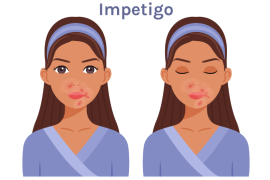Fifteen-year-old Natasha Ednan-Laperouse and her father were flying from London to France on a British Airways jet in July of 2016. Natasha was eating a baguette purchased before boarding from the Pret a Manger bakery at London’s Heathrow airport, when she suddenly had difficulty breathing. Her father quickly injected her with two EpiPens, but Natasha succumbed to anaphylaxis, tragically dying in flight. Natasha’s cause of death: sesame seeds. These food allergens were not listed on the baguette packaging ingredient list (Doward, 2018).
Defining Sesame
Sesame allergy is the only known seed allergy, and the ninth most prevalent in the United States (SAGE Digest, 2020). Sesame seeds are cultivated tropical or subtropical annual herbs that devel-op within capsules or pods on flowering sesame plants. The world’s biggest producers of these minute organisms are China, India, and Myanmar (formerly Burma), followed by the US. Southern states produce the most sesame in the US (KUKI, 2020).
From One to Millions
A sesame reaction was first documented in the New York State Journal of Medicine in 1950 (Torsney, 1964). Since that documentation, sesame allergies have increased significantly globally, especially in the past two decades, according to a 2010 survey as reported by Food Allergy Research & Education (FARE, 2020). The rate of growth in the US is so significant that world-renowned immunologist Dr. Robert A. Wood, professor of pediatrics and chief of pediatric Allergy and Immunology at Johns Hopkins University School of Medicine in Baltimore, says that sesame allergy cases have risen more than any other food allergy type over the last two decades. Wood reported that sesame had already risen to be the top fourth or fifth allergen among his 4,000 clinic patients in 2010, and that sesame is now one of the top six or seven allergens in the US. Israel reports that sesame is one of the top two or three most common allergens (Cronin & Stone, 2015).
A study led by Ruchi S. Gupta, MD, at the Northwestern University Feinberg School of Medicine of Chicago resulted in the discovery that 1.5 million US adults and children suffer from sesame allergies. Gupta’s study also indicated that half of those with a sesame allergy also had an additional allergy. This study, published in an August 2019 JAMA Network Open journal, also discovered that sesame allergy symptoms vary within individuals and may range from mild reactions like hives to severe reactions such as anaphylaxis, requiring an injection of epinephrine (Warren, Chadha, Sicherer, et al., 2019). Other sesame allergy symptoms include abdominal pain; facial flushing; itching in the eyes, throat, or mouth; swelling of the lips, face, tongue, uvula, and glottis; nausea; diarrhea; vomiting; coughing; asthma; wheezing; and difficulty breathing (Medical News Today, 2020).
Labeling Dilemma in the United States
Finding sesame ingredients on US food labels can be burdensome because of its many names and the fact that sesame is hidden within dips, sauces, snack foods, and is a favored ingredient among ethnic foods internationally. Dr. Gupta has been an advocate for FDA required labeling of sesame as an allergen ingredient on food packaging. In the United States, the Food Allergen Labeling and Consumer Protection Act (FALCPA) is the allergen labeling law. Currently, FALCPA does not require sesame or other seeds such as mustard to be listed on food labels, however, the FDA is considering this regulation (Federal Register, 2018).
According to a petition filed with the FDA by the Center for Science in the Public Interest, Australia, Canada, the European Union, and New Zealand all mandate the labeling of sesame on consumer food product packaging. This entity felt this fact provided the urgency and proof that the US should expediently follow suit (Center for Science in the Public Interest, 2018).
To date, Illinois is the only state to enact a state law requiring sesame to be listed on food packaging (Bloom, 2019). (snacksafely.com/2019/07/Illinois-enacts-law-requiring-food-manufacturers-to-label-for-sesame).
British-governed countries England, Wales, and Northern Ireland have resolved to prevent further tragedies from consumption of sesame by mandating Natasha’s Law, named for the 15-year-old who died after eating a baguette with sesame ingredients. Natasha’s posthumous legacy is a fulfillment of her parents’ wishes and will be established by the summer of 2021. It requires all ingredients to be listed on food packaging within a two-year period (BBC News, 2019).
Nonfood Sesame Allergens
Certain cosmetics, medicines, and insect repellents also contain sesame or sesame-based products. Some of these items include sunscreens, lipstick, lotions, soaps, and hair products.
Accommodating Sesame Allergies at Camp
Just as in other food allergy accommodation, successfully meet the needs of your campers and fellow staff with sesame allergies by:
1. Identification
- Identification of campers with the allergen via camper registration/food allergy forms
- Consistent method of food allergy notification at meal and snack times (bracelet, card, color coded name tag, etc.)
2. Communication from:
- Administration to food service manager
- Food service manager to parents
- Administration to counselors, program staff who need to know for cookouts, etc.
- Administration to camp nurse
- Food service manager to food service staff
3. Vigilance
- Consistent and vigilant surveillance for allergen within foods. Read all labels.
As with other food allergies, sesame is also listed by other names and in many other forms. (See the Sesame Ingredient Avoidance List for more details.)
Sesame Ingredient Avoidance List
Names for Sesame
- Ajonjoli, Ajonjolies
- Alegria
- Benne, Benne Seed or Bene Seed, Benniseed
- Gingelly, Gingilly, Gingelly Oil, Gingilly Oil
- Goma, Kura Goma (Japanese)
- Gomasio, Gomashio (Sesame Salt)
- Halva, Halvah, Halavah
- Jai Jinedra (Black Sesame Seeds)
- Milakai Powder
- Pasteli
- Sesame, Sesamo, Sesame Oil
- Sesame Flour, Sesame Paste, Sesame Salt
- Tajini, Tahini, Tahina, Tehina, Tahini Sauce
- Sesamol, Sesomolina, Sesarmol
- Sesamum Indicum (Latin)
- S. Indicum, S. Radiatum, S. Schum,
- S. Thorum, S. Albumin
- Sim Sim
- Til (Hindi), Til Oil, Teel
- Black Til
Foods That May Contain Sesame
- Asian, Greek, and Middle Eastern Foods
- Baba Ghanoush
- Breads, Bagels, Breadcrumbs, Buns
- Cereals, Chips, Crackers
- Dressings, Gravies, Marinades
- Energy and Protein Bars
- Falafel
- Flavor, Flavoring
- Flavored Rice, Noodles, Risotto, Stir Fry
- Granola, Granola Bars, Muesli
- Herbs, Herbal Teas
- Hummus
- Natural Flavorings, Other Flavors
- Pretzels, Rice Cakes
- Salad Kits
- Sauces
- Seasonings
- Seeds
- Soups and Stews
- Spices
- Sushi
- Tempeh
- Tocopherols (Foods fortified with Vitamin E)
- Turkish Cake
- Vegetable Oil
- Vegetarian Burgers
- Wasabi
Note: If sesame is not listed for vague ingredients like “seeds” or “seasonings” you may need to call the manufacturer and ask if sesame was specifically used as an ingredient.
Nonfood Ingredients That May Contain Sesame
- Cosmetics: lipstick, lip balm, soap, shampoo, lotion, sunscreen, cleanser, brow liner, spa products, etc.
- Repellents: insect, snail, and slug
- Over-the-counter medications
These products may list any of the following ingredients:
- Sesame
- Natural, Organic, Unrefined, or Virgin Sesame (Seed) Oil
- Hydrogenated Sesame Seed Oil
- Sesamum Indicum (Sesame) Oil Unsaponifiables
- Sesamum Indicum (Sesame) Seed Oil
- Sodium Sesameseedate
Resources
- BBC News. (2019, June 25). Pret allergy death: Parents ‘delighted’ by ‘Natasha’s Law’ plan. Retrieved from bbc.com/news/uk-politics-48752388
- Bloom, D. (2019, July 31). Illinois enacts law requiring food manufacturers to label for sesame. SnackSafely.com. Retrieved from snacksafely.com/2019/07/Illinois-enacts-law-requiring-food-manufacturers-to-label-for-sesame
- Center for Science in the Public Interest. (2018, December 31). CSPI comments to FDA re: Sesame as an allergen in foods. CSPI. Retrieved from cspinet.org/resource/cspi-comments-fda-re-sesame-allergen-foods
- Cronin, J. & Stone, A. (2015, September 17). Major manufacturers fail to disclose sesame, even when asked. Center for Science in the Public Interest. Retrieved from cspinet.org/new/201509171.html
- Doward, J. (2018, September 29). Pret allergy death: parents describe final moments with their daughter. The Guardian. Retrieved from theguardian.com/society/2018/sep/29/pret-allergy-death-parents-demand-label-laws
- Federal Register. (2018, October 24). A notice by the Food and Drug Administration. Food and Drug Administration. Retrieved from federalregister.gov/documents/2018/10/30/2018-23635/sesame-as-an-allergen-in-foods
- Food Allergy Research & Education (2020). Sesame allergy. FARE. Retrieved from foodallergy.org/living-food-allergies/food-allergy-essentials/common-allergens/sesame
- KUKI. (2020). What is sesame? Retrieved from kukisesame.com/what-is-sesame
- Medical News Today. (2020). Foods to avoid with a sesame allergy. Retrieved from medicalnewstoday.com/articles/322743
- SAGE Digest. (2020). Allergy law update: No open sesame. Retrieved from sagedining.com/digest/post/143032/allergy-law-update-no-open-sesame
- Torsney, P. J. (1964, November). Hypersensitivity to sesame seed. The Journal of Allergy and Clinical Immunology. Retrieved from jacionline.org/article/0021-8707(64)90083-8/fulltext#back-bib1
- Warren, C. M., Chadha, A. S., Sicherer, S. H., et al. (2019, August 2). Prevalence and severity of sesame allergy in the United States. JAMA Network Open. Retrieved from jamanetwork.com/journals/jamanetworkopen/fullarticle/2740786
Kimberly Whiteside Truitt is former food service manager at Camp Gilmont and Camp Zephyr, and has served on Camping Magazine’s Editorial Advisory Committee. Kimberly was a presenter at the 2018 North American Food Service and Maintenance Conference.



